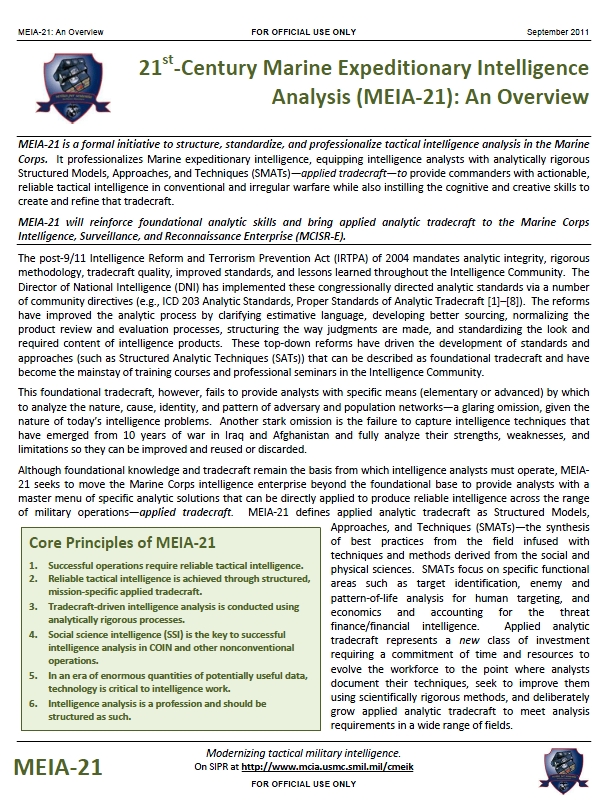The following is a short overview of a longer, twenty-page report on the U.S. Marine Corps 21st‐Century Marine Expeditionary Intelligence Analysis (MEIA‐21) initiative.
21st‐Century Marine Expeditionary Intelligence Analysis (MEIA‐21): An Overview
- 4 pages
- September 2011
MEIA‐21 is a formal initiative to structure, standardize, and professionalize tactical intelligence analysis in the Marine Corps. It professionalizes Marine expeditionary intelligence, equipping intelligence analysts with analytically rigorous Structured Models, Approaches, and Techniques (SMATs)—applied tradecraft—to provide commanders with actionable, reliable tactical intelligence in conventional and irregular warfare while also instilling the cognitive and creative skills to create and refine that tradecraft.
MEIA‐21 will reinforce foundational analytic skills and bring applied analytic tradecraft to the Marine Corps Intelligence, Surveillance, and Reconnaissance Enterprise (MCISR‐E).
The post‐9/11 Intelligence Reform and Terrorism Prevention Act (IRTPA) of 2004 mandates analytic integrity, rigorous methodology, tradecraft quality, improved standards, and lessons learned throughout the Intelligence Community. The Director of National Intelligence (DNI) has implemented these congressionally directed analytic standards via a number of community directives (e.g., ICD 203 Analytic Standards, Proper Standards of Analytic Tradecraft [1]–[8]). The reforms have improved the analytic process by clarifying estimative language, developing better sourcing, normalizing the product review and evaluation processes, structuring the way judgments are made, and standardizing the look and required content of intelligence products. These top‐down reforms have driven the development of standards and approaches (such as Structured Analytic Techniques (SATs)) that can be described as foundational tradecraft and have become the mainstay of training courses and professional seminars in the Intelligence Community.
This foundational tradecraft, however, fails to provide analysts with specific means (elementary or advanced) by which to analyze the nature, cause, identity, and pattern of adversary and population networks—a glaring omission, given the nature of today’s intelligence problems. Another stark omission is the failure to capture intelligence techniques that have emerged from 10 years of war in Iraq and Afghanistan and fully analyze their strengths, weaknesses, and limitations so they can be improved and reused or discarded.
Although foundational knowledge and tradecraft remain the basis from which intelligence analysts must operate, MEIA‐21 seeks to move the Marine Corps intelligence enterprise beyond the foundational base to provide analysts with a master menu of specific analytic solutions that can be directly applied to produce reliable intelligence across the range of military operations—applied tradecraft. MEIA‐21 defines applied analytic tradecraft as Structured Models, Approaches, and Techniques (SMATs)—the synthesis of best practices from the field infused with techniques and methods derived from the social and physical sciences. SMATs focus on specific functional areas such as target identification, enemy and pattern‐of‐life analysis for human targeting, and economics and accounting for the threat finance/financial intelligence. Applied analytic tradecraft represents a new class of investment requiring a commitment of time and resources to evolve the workforce to the point where analysts document their techniques, seek to improve them
using scientifically rigorous methods, and deliberately grow applied analytic tradecraft to meet analysis requirements in a wide range of fields.…
Social Science Intelligence
Contending with conventional, counterinsurgency (COIN), and nonconventional operations in the upcoming decades of the 21st century, Marines will be exposed to socially complex environments and hybrid armed groups. Many of these threats (conventional and nonconventional) and adversaries (state, state proxies, and nonstate actors) will be more agile, less visible, and possess an information advantage where it is easier for them to see and target us than for us to see and target them.
Given this operational environment, the MCISR‐E must analyze more than an adversary’s characteristics and capabilities. Expeditionary intelligence must address the context within which adversaries operate; the institutions within which they live; and their fears, perceptions, and motivations; in short, we must consider the totality of the human sphere as it applies to our adversaries.
This new approach to intelligence analysis, focusing on understanding human social organization is called Social Science Intelligence (SSI). There has been significant growth in the techniques and technologies of intelligence analysis, especially in the social sciences such as economics, political science, anthropology, and other disciplines relating to the study of human behavior. Most advanced knowledge in these fields is hard to access because it is dispersed within academia and not directly focused on intelligence‐related problems. Consequently, it plays an inadequate role in tactical intelligence today— Marine intelligence analysts’ knowledge of human‐centered problems tends to be subjective, unscientific, technologically weak, and based mostly on the raw intuition and personal experience of the individual analyst.
The challenge is to develop, refine, and deploy applied techniques that enable us to understand the totality of the human domain framework with speed and precision. An analytic modernization plan that captures critical best practices, leverages the best social and physical science know‐how available, and makes available sophisticated analytic instruments that analysts can readily apply to intelligence problems is critical to success. When made available, these methods and approaches give analysts social and physical science expertise from the fields that parallel the questions faced by intelligence (e.g., accounting, organizational theory, elite analysis, political science, economics, and census/registry).

